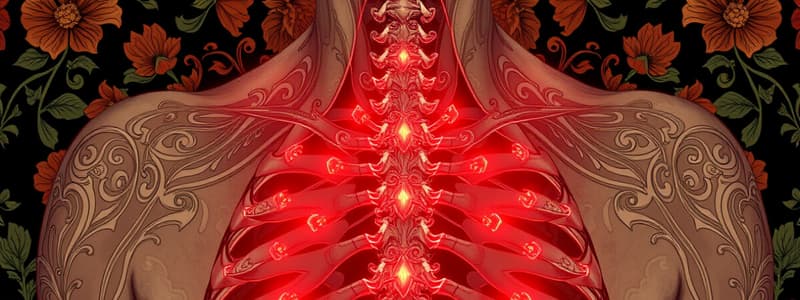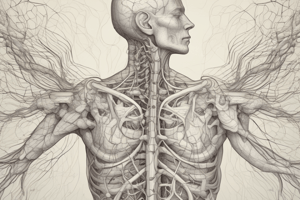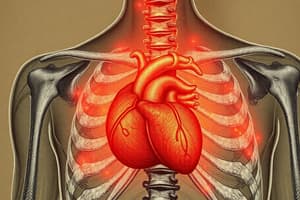Podcast
Questions and Answers
Which of the following is a characteristic sign associated with red flags in thoracic pain?
Which of the following is a characteristic sign associated with red flags in thoracic pain?
- Night pain or pain at rest (correct)
- Pain that improves with movement
- Gradual onset of symptoms
- Localized tenderness without systemic symptoms
What is a potential indicator for serious spinal pathology when assessing thoracic pain?
What is a potential indicator for serious spinal pathology when assessing thoracic pain?
- Mild intermittent discomfort
- Progressive and severe symptoms (correct)
- Pain during physical activity only
- Localized muscle strain without radiation
In cases of thoracic outlet syndrome, which non-mechanical pain characteristic is crucial for flagging severity?
In cases of thoracic outlet syndrome, which non-mechanical pain characteristic is crucial for flagging severity?
- Pain exacerbated by activity
- Pain present consistently without change (correct)
- Pain worsening only during specific movements
- Pain associated with visible inflammation
What forms of diagnosis are critical for confirming red flags in thoracic pain?
What forms of diagnosis are critical for confirming red flags in thoracic pain?
Which of the following distinguishes facet joint dysfunction from other thoracic pain disorders?
Which of the following distinguishes facet joint dysfunction from other thoracic pain disorders?
Which treatment should be prioritized for John to address thoracic pain effectively?
Which treatment should be prioritized for John to address thoracic pain effectively?
In Tania's case, what was one of the key findings during the physical examination?
In Tania's case, what was one of the key findings during the physical examination?
What is a characteristic symptom of Thoracic Outlet Syndrome as experienced by Tania?
What is a characteristic symptom of Thoracic Outlet Syndrome as experienced by Tania?
What was the result of the Neurological Examination conducted on Tania?
What was the result of the Neurological Examination conducted on Tania?
Which of the following statements accurately describes the role of manual therapy in thoracic pain management?
Which of the following statements accurately describes the role of manual therapy in thoracic pain management?
Which of the following is a common misconception about passive interventions in treating thoracic pain?
Which of the following is a common misconception about passive interventions in treating thoracic pain?
What aspect of Tania's swimming technique may have contributed to her thoracic pain and TOS diagnosis?
What aspect of Tania's swimming technique may have contributed to her thoracic pain and TOS diagnosis?
In the context of John's recurring issue, what factor has been identified regarding his activities?
In the context of John's recurring issue, what factor has been identified regarding his activities?
What symptom is most commonly associated with Thoracic Outlet Syndrome?
What symptom is most commonly associated with Thoracic Outlet Syndrome?
Which physical assessment technique is NOT typically used in a general assessment of thoracic pain?
Which physical assessment technique is NOT typically used in a general assessment of thoracic pain?
When assessing range of motion in the thoracic spine, what is the normal range for forward flexion?
When assessing range of motion in the thoracic spine, what is the normal range for forward flexion?
Which outcome measure is NOT commonly used for assessing thoracic pain?
Which outcome measure is NOT commonly used for assessing thoracic pain?
Which movement would likely suggest dysfunction of the thoracic spine based on pain assessment?
Which movement would likely suggest dysfunction of the thoracic spine based on pain assessment?
In the context of muscular strain in the thoracic region, what is a significant prognostic factor?
In the context of muscular strain in the thoracic region, what is a significant prognostic factor?
What range of motion is normal for thoracic spine rotation?
What range of motion is normal for thoracic spine rotation?
In the context of a herniated thoracic disc, what physical symptom is often observed?
In the context of a herniated thoracic disc, what physical symptom is often observed?
Flashcards are hidden until you start studying
Study Notes
Learning Objectives
- Understand the validity of red flags in clinical settings.
- Identify common causes of thoracic pain.
- Provide targeted treatments for various thoracic pain conditions.
Clinical Flags System
- Red Flags: Indicate serious pathology requiring immediate action and referral.
- Yellow Flags: Psychological, social, and environmental factors influencing recovery.
- Orange Flags: Serious psychiatric conditions needing immediate attention.
- Blue Flags: Patient's perceptions of work-related factors.
- Black Flags: Socio-occupational factors and contextual obstacles.
Red Flags Characteristics
- Severe and/or progressive symptoms.
- Non-mechanical pain.
- Pain at night or at rest.
- Accompanying systemic symptoms (e.g., fever, weight loss).
- Identification typically through detailed patient history and supported by imaging (MRI, CT) and lab tests (tumor markers).
Thoracic Pain Treatment Approaches
- Types of Exercises: Focus on mobility, strength, work capacity, and motor control.
- Manual Therapy: Temporary pain relief and improved mobility, not a long-term solution; no significant difference between thrust and non-thrust manipulations.
- Emphasis on exercise as the primary treatment, with manual therapy for pain relief and mobility enhancement.
Case Study: Tania
- Profile: 28-year-old professional swimmer with pain and tingling in the right arm for one month.
- Symptoms: Gradual onset, worsens with overhead activities, improves with rest, accompanied by numbness, tingling, and mild grip weakness.
- Diagnosis: Thoracic Outlet Syndrome (TOS).
- Physical Examination: Notable forward head posture, tenderness over scalene muscles, limited cervical and shoulder range of motion.
General Assessment of Thoracic Pain
- Detailed history to establish red flags and musculoskeletal versus non-musculoskeletal causes.
- Physical examination includes observation, active/passive range of motion, palpation, and manual muscle testing.
- Incorporate psychological and psychosocial factors into assessments.
Outcome Measures
- Utilize tools such as NRS or VAS, Patient-Specific Functional Scale, Roland-Morris Disability Questionnaire, and Oswestry Disability Index for comprehensive assessment.
- Evaluate quality of life and psychological symptoms (e.g., anxiety, fear-avoidance).
Active Movements of the Thoracic Spine
- Forward Flexion: 20° to 45°
- Extension: 25° to 45°
- Side Flexion: 20° to 40° both sides
- Rotation: 35° to 50° both sides
- Costovertebral Expansion: 3 to 7.5 cm
- Assess movement patterns, quality of movement, and pain response during evaluations.
Movement Analysis
- Pain indicates potential dysfunction and guides further assessments.
- Quality of movement must be normal; note any deviations or restrictions.
- Consider range of motion discrepancies and compare results across treatment sessions.
Additional Considerations
- Active movements, quality assessment, and understanding of joint play should be part of a comprehensive evaluation strategy.
- Engage the patient through pain education and encourage active participation in their rehabilitation process.
Studying That Suits You
Use AI to generate personalized quizzes and flashcards to suit your learning preferences.




